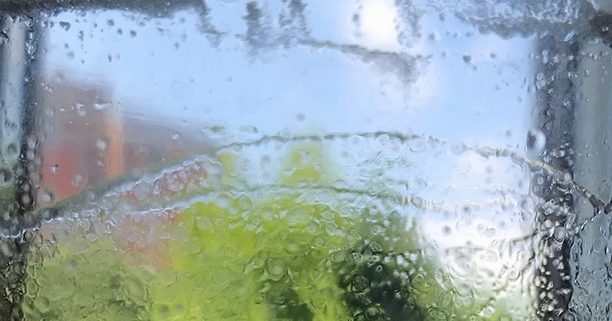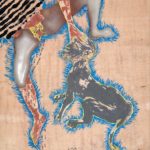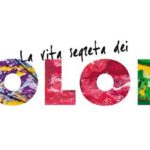MARIO AIRO’ – Galleria de’Foscherari – Bologna
MARIO AIRO’ – IL PIPISTRELLO BIANCO
INAUGURAZIONE SABATO 5 OTTOBRE ORE 18
DAL 5 OTTOBRE AL 7 DICEMBRE 2019
Bologna
Il titolo della mostra si riferisce ad una pubblicazione in cui l’autrice, con l’ausilio di anziani e giovani dongba (persone che officiano i riti, sciamani), traduce un libro rituale della tradizione Naxi, scritto nell’ultima lingua pittografica rimasta attiva ai giorni nostri. È una lettura estremamente affascinante e interessante: il racconto ha una grande potenza immaginifica e le figure mitiche che lo animano sono molto distanti dal nostro mondo mitologico e incarnano spinte spiritualestistenziali nate in un contesto molto molto diverso dal nostro brodo mediterraneo, in una terra appena al disotto delle grandi montagne himalaiane.
Mi dispiace dover dire che i lavori in mostra non cercano di essere attinenti a questo ricchissimo universo simbolico, né cercano di illustrarlo: solo sognano un’armonia affine e cercano di accordarla allo spazio che li circonda e alla nostra cultura che più che in decadenza sembra entrata in un accelerato volo a vite.
Le immagini guida che mi hanno condotto a ciò che troverete in mostra sono state, oltre ai pittogrammi naxi, la visione, in un documentario, del monte Kailash – una delle figure più portentose che mi sia capitato di incontrare, una di quelle che ti fa comprendere appieno la potenza apotropaica dell’immagine per l’uomo ( e non è casuale infatti che per tre grandi religioni sia il posto di congiunzione, di connessione delle energie tra terra e cielo, tra divino e umano) – e gli spettri di assorbimento degli elementi chimici, specialmente gli intervalli tra le loro bande di frequenza, veri accordi luminosi.
Che altro dire?, a voler essere rigorosi non bisognerebbe aggiungere più nulla: da qui in poi si entra in un territorio altro, nel reame dove a parlare sono le immagini e le forme tra di loro.
E bisogna seguire loro e come si muovono, come si connettono, si chiamano e richiamano tra loro, su linee di affinità e empatia; osservare come macinano e rimacinano la lingua madre, quella che darà loro sembianza forma senso e status simbolico, che darà loro apparenza e che donerà loro quell’incredibile potere di risonanza che riverberando farà ballare le nostre esangui sinapsi.
I lavori per fortuna sono e restano elusivi, sprezzantemente orgogliosi nella loro ermetica, annoiati dalle reiterate richieste di spiega.
Ma in fondo il contenuto non è così importante, o meglio, il contenuto è sensibile, è quel sensibile che è subito idea, che hai incontrato e immediatamente come una termica improvvisa ti ha avvitato al cielo.275 ottobre 2019
Mario Airò
MARIO AIRO’ – THE WHITE BAT
OPENING ON SATURDAY OCTOBER 5 AT 6 PM
ON VIEW FROM OCTOBER 5 TO DECEMBER 7 , 2019
The exhibition title alludes to a book in which the author, aided by elderly and younger dongba (leaders of rituals, shamans), has attempted to translate a religious manuscript from the Nakhi tradition, written in the last pictographic language to have survived into our time. It is truly fascinating to read: the story summons up powerful images, and the mythical figures that people it are a far cry from those of European culture, embodying spiritual and existential impulses that emerged from a context completely unlike our own Mediterranean soup, in a land at the foot of the towering Himalayas.
I am sorry to say that the works on view do not draw on this rich universe of symbols, nor do they try to illustrate it; they merely dream of a similar harmony, which they try to bring into tune with the surrounding space and with our culture, which doesn’t seem to have entered a decline so much as a spiraling plunge.
The guiding images that led me to what you will see in the exhibition were, aside from the Nakhi pictograms, those of a documentary showing Mount Kailash―one of the most extraordinary sights I have ever encountered, the kind that makes one fully grasp the apotropaic power that images hold for our species (it is no coincidence that three great religions consider it to be the meeting point of energies that flow between earth and sky, human and divine). And, too, the absorption spectra of the chemical elements, especially the intervals between their frequencies, which are true harmonies of light.
What else? I probably ought to leave it at that: from here on in, we are entering another realm, one where only images and forms can speak to each other.
And we must follow them and watch how they move, how they interconnect, call out to each other over and over, along lines of affinity and empathy; observe how they chew over and chew up the mother tongue, the language that will give them semblance form meaning and symbolic status, which will give them an guise and grant the incredible power of resonance that will reverberate to make our drained synapses dance.
Luckily, these works remain elusive, proudly and disdainfully hermetic, impatient with all nagging requests for explanation.
But in the end the content doesn’t really matter, or rather, is sensory, the kind of sensory impression that immediately becomes an idea: no sooner encountered than it lifts you, like a sudden thermal, in a spiral to the sky.
Mario Airò
Galleria de’ Foscherari
Via Castiglione 2B – Bologna tel + 39 051221308
www.defoscherari.com – galleria@defoscherari.com




